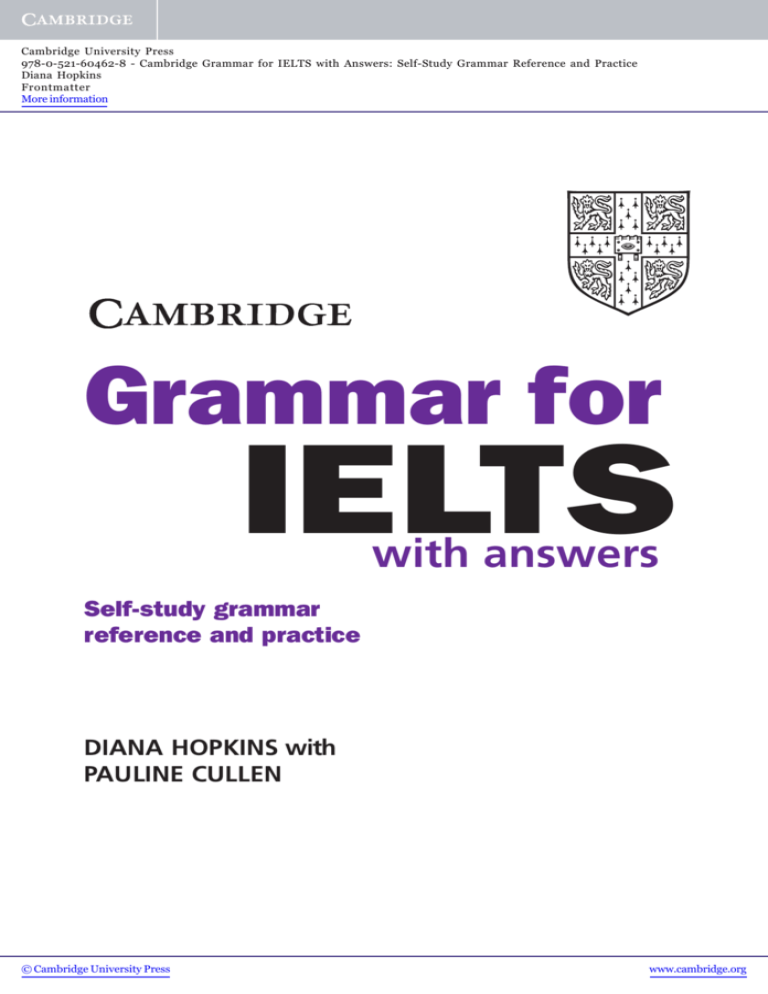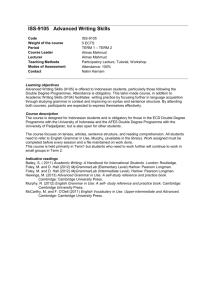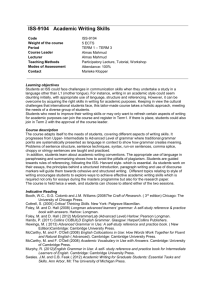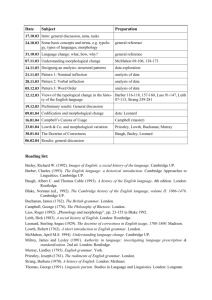
Cambridge University Press
978-0-521-60462-8 - Cambridge Grammar for IELTS with Answers: Self-Study Grammar Reference and Practice
Diana Hopkins
Frontmatter
More information
Grammar for
IELTS
with answers
Self-study grammar
reference and practice
DIANA HOPKINS with
PAULINE CULLEN
© Cambridge University Press
www.cambridge.org
Cambridge University Press
978-0-521-60462-8 - Cambridge Grammar for IELTS with Answers: Self-Study Grammar Reference and Practice
Diana Hopkins
Frontmatter
More information
CAMBRIDGE UNIVERSITY PRESS
Cambridge, New York, Melbourne, Madrid, Cape Town, Singapore, São Paulo
Cambridge University Press
The Edinburgh Building, Cambridge CB2 2RU, UK
www.cambridge.org
Information on this title: www.cambridge.org/9780521604628
© Cambridge University Press 2007
This publication is in copyright. Subject to statutory exception
and to the provisions of relevant collective licensing agreements,
no reproduction of any part may take place without the written
permission of Cambridge University Press.
First published 2007
Printed in the United Kingdom at the University Press, Cambridge
Text typeface GammEF 11.5/13pt System QuarkXpress(r) [KAMAE]
A catalogue record for this publication is available from the British Library
Library of Congress Cataloguing in Publication data
ISBN–13 978–0–521–60462–8
ISBN–10 0–521–60462–1
Produced by Kamae Design, Oxford.
© Cambridge University Press
www.cambridge.org
Cambridge University Press
978-0-521-60462-8 - Cambridge Grammar for IELTS with Answers: Self-Study Grammar Reference and Practice
Diana Hopkins
Frontmatter
More information
Acknowledgements
My thanks go firstly to my editor, Jessica Roberts, who has worked tirelessly and patiently with me and kept me going
through her endless words of encouragement. Thanks also to my commissioning editor, Alison Sharpe, whose
encouragement and gentle persuasion have led the project to completion, and to Anna Teevan, who saw me through the
initial stages. Many thanks also to all at Cambridge University Press who have contributed along the way, and to the
teachers and readers involved in commenting on the material. And of course I would like to thank Pauline Cullen,
without whom this book may never have quite reached the final stages and whose contribution has been much
appreciated.
Finally, a thank you to my children Laura and Alexander, my partner, Ned Garnett and my mother, for their support,
encouragement and help at every stage.
Diana Hopkins
The authors and publishers would like to thank the following teachers and readers who commented on the material
in its draft form:
Guy Brook-Hart, Valencia, Spain; Mike Gutteridge, Cambridge, England; Vanessa Jakeman, Hove, England; Barbara
Thomas, Cambridge, England.
The authors and publishers are grateful to the following for permission to reproduce copyright material. It has not
always been possible to identify the sources of all the material used and in such cases the publishers would welcome
information from the copyright owners.
p.14: New Scientist for the adapted article ‘Good vibrations help jumping spiders to hunt’ by Peter Aldous, 24 February
1996 from www.newscientist.com; p.60: The Economist for the text adapted from the article ‘Dressed to dazzle’ by Barney
Southin, and for p.71: listening text adapted from ‘Back on the treadmill’ by Konstantin Kakaes, Economist Intelligent
Life, Summer 2004, © The Economist Newspaper Limited; p.64: ESA for adapted listening text ‘World’s Largest
Switchboard for Climate Monitoring’ from www.innovations-report.com; p.87: Wcities for the adapted text from
www.wcities.com, Wcities © 2006; p.88: adapted from an article ‘Great Guide – Buying a Backpack’ in the Rambler,
former members’ magazine of the Ramblers’ Association, www.ramblers.org.uk; p.103: Professor Rajendra Persaud for the
text ‘Practical Intelligence Lends a Hand’ taken from www.caribvoice.org; p.113: Roger Hedge for the adapted text
‘Discovery and Prehistory of Soap’ from www.butser.org.uk; p.140: Professor John Maule for the adapted article ‘How
Consumers Decide’ from www.faradaypackaging.com; p.160: Bristol Magazines Ltd for the adapted article ‘We are family’
by Philip Dalton from BBC Wildlife Magazine, November 2004; p.180: Auspac Media for the adapted text from ‘Robotic
Approach to Crop Breeding’ by Jennifer Manyweathers, Australasian Science Magazine, March 2006; p.206: Scientific
American Inc., for article adapted from ‘Experience Versus Speed’ by Marion Sonnenmoser, Scientific American Mind,
Volume 16, Number 2, 2005, Copyright © 2005 by Scientific American Inc, All rights reserved.
Photographs: Alamy Images/©Stockdisc for p8 (crt), /©Mark Sykes for p8 (crb), /©D Hurst for p11 (r), /©Lebrecht Music
& Arts PL for p27, /©Rena Pearl for p80 (l), /©B.Mete Uz for p80 (m), /©Sciencephotos for p140, /©Motoring Picture
Library for p144 (l), /©Epictura for p144 (ml), /©Image Broker for p169; Corbis Images/©Bettmann for p11 (l), /©David
Ball for p38 (c), /©Gideon Mendel for p41, /©Charles Jean Marc/Sygma for p42, /©Viviane Moos for p80 (r), /©Richard
Klune for p98 (l), /©Stephen Frink for p 98 (r), /©Royalty Free for p144 (cr), /©Chris Collins for p144 (br), /©Keith
Dannemiller for p150, /©Guenter Rossenbach/Zefa for p188, /©Photocuisine for p198; Dell for p8 (cl);
Empics/©AP/Vincent Thian for p69; FLPA/©Mark Moffett/Minden Pictures for p14; Getty Images for pp8 (r), 38 (r), 90;
Photolibrary.com/©Thom DeSanto for p8 (c), /©Royalty Free for p38 (l); Punchstock/©Image Source for p144 (tr),
/©Digital Vision for p160, /©Image Source for p154, /©Bananastock for p210 (l); Rex Features for pp8 (l), 32, 64, 210 (r);
Royal Ontario Museum ©ROM for p112 (reproduced with permission); Topfoto/©UPP for p158.
Key: l = left, c = centre, r = right, t = top, b = bottom
Picture Research by Hilary Luckcock
iii
© Cambridge University Press
www.cambridge.org
Cambridge University Press
978-0-521-60462-8 - Cambridge Grammar for IELTS with Answers: Self-Study Grammar Reference and Practice
Diana Hopkins
Frontmatter
More information
Contents
Introduction
Entry test
vii
ix
1 Present tenses
1
6
present simple; present continuous; state verbs
Test practice: Listening Section 1
2 Past tenses 1
8
14
past simple; past continuous; used to; would
Test practice: Academic Reading
3 Present perfect
18
25
present perfect simple; present perfect continuous
Test practice: General Training Writing Task 1
4 Past tenses 2
27
34
past perfect simple; past perfect continuous
Test practice: Academic Reading
5 Future 1
plans, intentions and predictions: present continuous; going to; will
Test practice: General Training Reading
38
44
6 Future 2
present simple; be about to; future continuous; future perfect
Test practice: Academic Writing Task 2
48
54
7 Countable and uncountable nouns
countable and uncountable nouns; quantity expressions (many, much, a lot of, some, any, a few, few, no)
Test practice: Academic Reading
55
60
8 Referring to nouns
articles; other determiners (demonstratives, possessives, inclusives: each, every, both, all etc.)
Test practice: Listening Section 4
64
71
9 Pronouns and referencing
personal, possessive and reflexive pronouns; avoiding repetition
Test practice: Academic Writing Task 2
73
79
10 Adjectives and adverbs
describing things; adding information about manner, place, time, frequency and intensity
Test practice: General Training Reading
80
87
iv
© Cambridge University Press
www.cambridge.org
Cambridge University Press
978-0-521-60462-8 - Cambridge Grammar for IELTS with Answers: Self-Study Grammar Reference and Practice
Diana Hopkins
Frontmatter
More information
11 Comparing things:
comparative and superlative adjectives and adverbs; other ways of comparing
Test practice: Academic Writing Task 1
90
97
12 The noun phrase
noun + prepositional phrase; noun + participle clause; noun + to-infinitive clause
Test practice: Academic Reading
98
103
13 Modals 1
107
113
ability; possibility; alternatives to modals
Test practice: Listening Section 4
14 Modals 2
obligation and necessity; suggestions and advice; adverbs
Test practice: General Training Reading
114
120
15 Reported speech
tense changes; time references; reporting questions; reporting verbs
Test practice: Listening Section 3
123
131
16 Verb + verb patterns
verb + to-infinitive; verb + -ing; verb + preposition + -ing; verb + infinitive without to
Test practice: Academic Reading
133
140
17 Likelihood based on conditions 1
zero, first and second conditionals; other ways to introduce a condition
Test practice: Academic Reading
144
150
18 Likelihood based on conditions 2
third conditional; mixed conditionals; wishes and regrets; should(n’t) have
Test practice: Academic Reading
154
160
19 Prepositions
prepositions after verbs, adjectives and nouns; prepositional phrases
Test practice: Listening Section 2
164
171
20 Relative clauses
relative pronouns; defining and non-defining relative clauses; prepositions
Test practice: Academic Reading
173
180
v
© Cambridge University Press
www.cambridge.org
Cambridge University Press
978-0-521-60462-8 - Cambridge Grammar for IELTS with Answers: Self-Study Grammar Reference and Practice
Diana Hopkins
Frontmatter
More information
21 Ways of organising texts
subject choice; introductory it; ellipsis; organising information; it- and what-clauses
Test practice: Academic Writing Task 2
184
190
22 The passive
the passive; reporting with passive verbs; have something done; need + -ing
Test practice: Academic Writing Task 1
191
197
23 Linking ideas
conjunctions, adverbials and prepositions; linking expressions
Test practice: Academic Reading
198
206
24 Showing your position in a text
210
215
pronouns; adverbs; verbs; adjectives
Test practice: Academic Writing Task 2
25 Nominalisation in written English
forming nouns from other parts of speech (verbs, adjectives and linking words)
Test practice: Academic Writing Task 1
216
222
Key
223
Recording scripts
240
Appendix 1: Irregular verbs
256
Appendix 2: Phrasal verbs
257
CD tracklist
258
vi
© Cambridge University Press
www.cambridge.org
Cambridge University Press
978-0-521-60462-8 - Cambridge Grammar for IELTS with Answers: Self-Study Grammar Reference and Practice
Diana Hopkins
Frontmatter
More information
Introduction
To the student
D: Test practice Each unit has a test task.
These help you practise the different parts of
the test. The test task is followed by a
grammar focus task, which gives you extra
practice in the grammar from the unit.
Who is this book for?
This book is for anyone preparing for IELTS.
Although the IELTS test does not include a
specific grammar module, it is important to
be able to recognize and use grammar
appropriately. This book covers the grammar
you will need to be successful in the test. You
can use it to support an IELTS coursebook,
with a general English language course for
extra grammar practice, or with practice tests
as part of a revision programme. You can use
it in class or for self-study.
The Key
The Key contains:
■ answers for all the exercises. Check your
answers at the end of each exercise. The
Key tells you which part of the Grammar
section you need to look at again if you
have any problems.
■ sample answers for exercises where you
use your own ideas to help you check your
work.
■ test tips for each exercise type in the Test
practice section.
■ sample answers for all the writing tasks in
the Test practice section. Read these after
you have written your own answer. Study
the language used and the way the ideas
are organised.
How do I use this book?
There are two ways to use this book. You can
either start at Unit 1 and work through to the
end of the book, or you can do the Entry test
on page ix to find out which units you need
most practice in and begin with those.
What is in this book?
This book contains 25 units. Each unit is in
four parts:
A: Context listening This introduces the
grammar of the unit in a context that is
relevant to the IELTS test. This will help you
to understand the grammar more easily when
you study section B. It also gives you useful
listening practice. Listen to the recording and
answer the questions. Then check your
answers in the Key before you read the
Grammar section.
Recording scripts
There are recording scripts for the Context
listenings in each unit and for the Test
practice listening tasks. Do not look at the
script until after you have answered the
questions. It is a good idea to listen to the
recording again while you read the script.
The Entry test
You can do this test before using the book to
help you choose what to study. Answer the
questions and then check your answers in the
Key. The Key tells you which units are most
important for you.
B: Grammar Read through this section
before you do the grammar exercises. For
each grammar point there are explanations
with examples. You can refer back to this
section when you are doing the exercises.
C: Grammar exercises Write your answers to
each exercise and then check them in the Key.
vii
© Cambridge University Press
www.cambridge.org
Cambridge University Press
978-0-521-60462-8 - Cambridge Grammar for IELTS with Answers: Self-Study Grammar Reference and Practice
Diana Hopkins
Frontmatter
More information
To the teacher
C: Grammar exercises This section can be
done in class or set as homework. Students
can be encouraged to check their own work
and discuss any difficulties they encounter.
This book offers concise yet comprehensive
coverage of the grammar necessary in order
to be successful in the IELTS test. It can be
used for self-study or with a class. It will be
particularly useful for a class where all the
students are preparing for IELTS. It will also
be useful for revision, and for candidates in
classes where some students are not entered
for the test, as sections A, B and C are
designed to be useful for all students.
D: Test practice This section can be used to
familiarize students with the test task types
while offering further practice in the
grammar for each unit. Each task is followed
by a Grammar focus task, designed to raise
students’ awareness of a particular language
point covered in that unit. The book contains
at least one task from each part of the
Listening, Academic Reading, General
Training Reading, Academic Writing and
General Training Writing modules.
The Entry test
The Entry test can be used diagnostically as a
means of prioritising the language areas to be
covered, either for a class, or for individual
students.
In classes where there are students who are
not entered for the test, you may prefer to set
Section D tasks as extra work for IELTS
candidates only. However, they offer all
students valuable opportunities to practise
the grammar of the unit and provide an
effective teaching resource for EAP classes.
A: Context listening This section is suitable
for classroom use. Many of the tasks can be
done in pairs or small groups if appropriate.
B: Grammar This section is designed for
private study, but you may wish to discuss
those parts which are particularly relevant to
your students’ needs.
viii
© Cambridge University Press
www.cambridge.org
Cambridge University Press
978-0-521-60462-8 - Cambridge Grammar for IELTS with Answers: Self-Study Grammar Reference and Practice
Diana Hopkins
Frontmatter
More information
Entry test
You can do this test before using the book to help you choose what to study. Choose the correct
answer, A, B or C, for each question. When you have finished, check your answers on page 223.
The key tells you which units are most important for you.
1 Most university students
campus in their first year.
A lives
B live
C are living
7
on
the experiment three times
now with different results each time!
A We’ve done
B We did
C We’ve been doing
2 From this graph we can see that the
economy
at the moment.
A improves
B improve
C is improving
8 When I arrived the lecture
I didn’t find it easy to follow.
A started
B had started
C had been starting
3 They
personal computers
when my father was a student.
A hadn’t
B didn’t have
C weren’t having
9 She
well at school but that
changed when she became friends with
a different group of girls.
A did
B had done
C had been doing
4 I
want to be a practising
doctor but now I’m more interested in
research.
A was used to
B used to
C would
10
so
the doctor at 2.00 this
afternoon so I can’t go to the lecture.
A I’m seeing
B I see
C I will see
5 The teacher
us how to do the
experiment when the fire bell rang.
A showed
B shown
C was showing
11 My sister
economics and
politics when she goes to university.
A is going to study
B studies
C will study
6 I finished my essay yesterday but
it in to the tutor yet.
A I’ve given
B I haven’t given
C I didn’t give
12 While we’re working on the project our
boss
on a beach in Greece!
A will sit
B will have sat
C will be sitting
ix
© Cambridge University Press
www.cambridge.org
Cambridge University Press
978-0-521-60462-8 - Cambridge Grammar for IELTS with Answers: Self-Study Grammar Reference and Practice
Diana Hopkins
Frontmatter
More information
25
13 If the trend continues, the average
income
by 107% by 2020.
A will increase
B will have increased
C will be increasing
20 You should visit Bath. It’s
city.
A a historical and interesting
B a historical interesting
C an interesting historical
14 You can base your geography
assignment on
country – it
doesn’t matter which.
A a
B some
C any
21 The government has released some
data showing how schools are
not providing an adequate education to
our children.
A shocking
B shock
C shocked
15 There aren’t
places left on
the course so you’d better apply soon.
A much
B many
C lots of
22 You really should go to Namibia. The
scenery is
stunning and the
people are very friendly.
A very
B fairly
C absolutely
16 I don’t know whether to accept the job
offer. It’s
.
A a difficult decision
B the difficult decision
C difficult decision
23 This factory produces some of
cameras in the world.
A best
B the best
C the most best
17 For those of you new to the company,
this leaflet is full of
.
A a valuable information
B the valuable information
C valuable information
24
18 The manager interviewed
candidates in turn.
A each of the
B each
C every
people live in the countryside
than 100 years ago.
A Less
B Few
C Fewer
25 The bookshop
road is excellent.
A at
B on
C in
19 I know it’s not much of a present but I
made it
.
A me
B myself
C by myself
the end of the
x
© Cambridge University Press
www.cambridge.org
Cambridge University Press
978-0-521-60462-8 - Cambridge Grammar for IELTS with Answers: Self-Study Grammar Reference and Practice
Diana Hopkins
Frontmatter
More information
Present
Entry
Tenses
test
26 There were millions of people around
the world
the football match
live on television.
A watched
B watching
C were watching
32
this newspaper report, more
women smoke than men nowadays.
A Apparently
B According to
C Supposedly
33 My parents encouraged
course.
A me to do
B me doing
C me do
27 Scientists finally
find a cure
for the disease after years of research.
A managed to
B can
C could
this
34 What will you do if
A you don’t get a good IELTS score?
B you didn’t get a good IELTS score?
C you won’t get a good IELTS score?
28 She got a terrible mark in the exam so
she
very hard at all.
A mustn’t have worked
B can’t have worked
C didn’t work
35 A recent government report has warned
that
we act immediately to
reduce pollution, there will be serious
consequences for the planet.
A provided that
B in case
C unless
29 What
in order to get a permit
to work in your country?
A do I need to do
B must I do
C ought I do
30 When you write your essays you
copy ideas from books
without referencing them properly.
A mustn’t
B don’t have to
C have to
36 If I didn’t have to work tonight,
A I’d be able to relax now.
B I’m able to relax now.
C I’ll be able to relax now.
37 I wish that man
tapping his
fingers on the table. It’s really
annoying me.
A stopped
B had stopped
C would stop
31 Doctors have
us to cut down
on salt in our diets if we want to reduce
the risk of getting heart disease.
A insisted
B suggested
C advised
38 I’m aiming
A on
B for
C to
a band 7 in IELTS.
xi
© Cambridge University Press
www.cambridge.org
Cambridge University Press
978-0-521-60462-8 - Cambridge Grammar for IELTS with Answers: Self-Study Grammar Reference and Practice
Diana Hopkins
Frontmatter
More information
25
39 Do you have any knowledge
how our education system works?
A of
B on
C for
45 I can’t pick you up from the station on
Wednesday because
on that
day.
A I’m fixing my car
B I’m having my car fixed
C I need my car fixed
40 The minister
is responsible
for education has just resigned.
A which
B who
C what
46 These drugs are the best medicine
available as a treatment at the moment,
they are expensive,
unfortunately.
A although
B because
C so
41 The University of St Andrews
is the oldest university in Scotland.
A which was founded in 1413
B , which was founded in 1413,
C , that was founded in 1413,
47 Learning a foreign language is important
because it helps you to understand other
cultures better.
it can be a
useful skill in many areas of work.
A However,
B Despite this,
C In addition,
42 Many children these days do not have a
healthy diet.
is possible that
this is because less healthy foods are
cheaper than healthy ones.
A What
B That
C It
43 The charity is trying to find ways to
save and
the world’s
endangered animal species.
A the charity is trying to find ways to
protect
B to find ways to protect
C protect
44 In the past we threw a lot of our
kitchen waste away, but today many
items such as plastic bottles and
newspapers
.
A are recycled
B recycle
C need recycling
48
I can’t go to the conference as
I’ve got to go to Sydney on business.
A Frankly
B Unfortunately
C Personally
49
I think it’s useful to write an
outline of your essay before you start to
write the first draft.
A Interestingly,
B Definitely,
C Personally,
50 The
of dark red spots is one
of the first signs of the disease.
A appearance
B appearing
C appear
xii
© Cambridge University Press
www.cambridge.org









